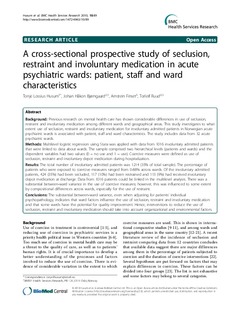| dc.contributor.author | Husum, Tonje Lossius | |
| dc.contributor.author | Bjørngaard, Johan Håkon | |
| dc.contributor.author | Finset, Arnstein | |
| dc.contributor.author | Ruud, Torleif | |
| dc.date.accessioned | 2015-09-11T11:33:53Z | |
| dc.date.accessioned | 2018-03-21T14:17:57Z | |
| dc.date.available | 2015-09-11T11:33:53Z | |
| dc.date.available | 2018-03-21T14:17:57Z | |
| dc.date.issued | 2010 | |
| dc.identifier.citation | BMC Health Services Research 2010, 10 | nb_NO |
| dc.identifier.issn | 1472-6963 | |
| dc.identifier.uri | http://hdl.handle.net/11250/2491549 | |
| dc.description | - | nb_NO |
| dc.description.abstract | Background
Previous research on mental health care has shown considerable differences in use of seclusion, restraint and involuntary medication among different wards and geographical areas. This study investigates to what extent use of seclusion, restraint and involuntary medication for involuntary admitted patients in Norwegian acute psychiatric wards was associated with patient, staff and ward characteristics. The study includes data from 32 acute psychiatric wards.
Methods
Multilevel logistic regression using Stata was applied with data from 1016 involuntary admitted patients that were linked to data about wards. The sample comprised two hierarchical levels (patients and wards) and the dependent variables had two values (0 = no use and 1 = use). Coercive measures were defined as use of seclusion, restraint and involuntary depot medication during hospitalization.
Results
The total number of involuntary admitted patients was 1214 (35% of total sample). The percentage of patients who were exposed to coercive measures ranged from 0-88% across wards. Of the involuntary admitted patients, 424 (35%) had been secluded, 117 (10%) had been restrained and 113 (9%) had received involuntary depot medication at discharge. Data from 1016 patients could be linked in the multilevel analysis. There was a substantial between-ward variance in the use of coercive measures; however, this was influenced to some extent by compositional differences across wards, especially for the use of restraint.
Conclusions
The substantial between-ward variance, even when adjusting for patients' individual psychopathology, indicates that ward factors influence the use of seclusion, restraint and involuntary medication and that some wards have the potential for quality improvement. Hence, interventions to reduce the use of seclusion, restraint and involuntary medication should take into account organizational and environmental factors. | nb_NO |
| dc.language.iso | eng | nb_NO |
| dc.relation.uri | http://www.biomedcentral.com/1472-6963/10/89 | |
| dc.rights | Navngivelse 4.0 Internasjonal | * |
| dc.rights.uri | http://creativecommons.org/licenses/by/4.0/deed.no | * |
| dc.title | A cross-sectional prospective study of seclusion, restraint and involuntary medication in acute psychiatric wards: patient, staff and ward characteristics | nb_NO |
| dc.type | Journal article | nb_NO |
| dc.date.updated | 2015-09-11T11:33:53Z | |
| dc.description.version | publishedVersion | nb_NO |
| dc.source.journal | BMC Health Services Research | nb_NO |
| dc.identifier.doi | 10.1186/1472-6963-10-89 | |
| dc.identifier.cristin | 342125 | |

